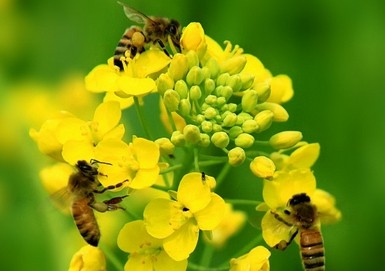(单词翻译:单击)
听力文本
This is Scientific American — 60-Second Science. I'm Christopher Intagliata.
Walk through Times Square—you're bombarded with advertising. And it turns out, a bumblebee might have a similar feeling, buzzing through a field of flowers. "So these flowers are these billboards, they're advertising a good, this delicious nectar reward, and bees are very picky shoppers." Anne Leonard, a pollination biologist at the University of Nevada, Reno.
She describes a flower field as a sort of pollination marketplace. And one way bees choose where to visit? "Bees are nectar experts. They are really good at assessing even really small differences in the sugar concentration of nectar." They also scope out the shape and size of the flowers, and their color and scent. And now Leonard and her colleagues have discovered that bumblebees are pollen aficionados, too.
They found that out by lacing batches of cherry pollen with either table sugar or bitter quinine. And to display the pollen to bees, "We got really into it—we started 3-D printing flowers in our lab." And for the anther—the male flower part, which presents the pollen—pipe cleaners. "So we bought out Michael's craft store supplies of these pipe cleaners and used them in our experiments."

Turns out bees would return again and again to the same color flower that dispensed sweet pollen, and spend more time collecting there. But when confronted with the bitter pollen? They sought a different colored flower for their very next stop. All of which suggests that, in addition to savoring nectar, bees taste pollen too—and judge flowers by it. The results are in the journal Biology Letters.
The finding means that plants have to find a happy medium: "So can you make your pollen attractive enough that the bees will collect it, but distasteful enough that they won't collect too much of it?" And that balancing act, of carefully calibrated chemistry—it's just one of the many transactions that plays out in the buzzing pollination marketplace. Where the object is to make a sweet profit.
Thanks for listening for Scientific American — 60-Second Science Science. I'm Christopher Intagliata.
参考译文
这里是科学美国人——60秒科学。我是克里斯托弗·因塔利亚塔。
走过纽约时代广场,你会被广告不断侵扰。事实证明,熊蜂在嗡嗡地飞过花田时,可能会有类似的感觉。“因为这些花朵就像是那些广告牌,它们在为这些美味可口的花蜜打广告,而蜜蜂就是那些非常挑剔的消费者。”内华达州立大学雷诺分校的传粉生物学家安妮·伦纳德说道。
她将花田描述为一个授粉市场。蜜蜂选择去哪里采集花蜜的方法是什么?“蜜蜂是花蜜专家。它们很擅长评估花蜜,即使花蜜糖的浓度存在微小的区别它们也能感觉到。”它们还能确定花的形状、大小、颜色和气味。现在伦纳德和她的研究团队发现,熊蜂也是花粉爱好者。
他们通过给不同批次分别含有甜蔗糖和苦奎宁的樱桃花粉系上标签的方法进行研究,并得到了上述结论。为了向蜜蜂展示花粉,“我们进行了非常深入地研究,我们开始在实验室用3D技术打印花朵。”在花药部分,也就是呈现出花粉的雄花部分使用清管器。“所以我们购买了迈克尔工艺品店的清管器,将这些清管器应用到我们的实验中。”
实验证明,蜜蜂会在含有甜蔗糖花粉的相同颜色花朵间重复往返,并且花费更多的时间来采集。那它们遇到含有苦奎宁的花粉时会怎样呢?它们会在下一次停留时寻找一种与之颜色不同的花朵。所有这一切表明,除了品尝花蜜,蜜蜂也会品尝花粉的味道,并且通过花粉来对花朵进行评估。该研究结果刊登在《生物学快报》杂志上。
该研究结果表明,植物必须找到一个折中的办法:“你能让你的花粉有足够的吸引力,让蜜蜂来采集,但是又让花粉不太合口,确保蜜蜂不会采集太多吗?”这一精确校准化学的平衡做法,只是蜜蜂授粉市场上进行的众多交易中的其中一种。该市场的目标是获得“甜蜜”的利润。
谢谢大家收听科学美国人——60秒科学。我是我是克里斯托弗·因塔利亚塔。
译文为可可英语翻译,未经授权请勿转载!
重点讲解
重点讲解:
1. be good at 擅长的;精通的;能干的;
例句:The conductor is good at keeping the players together.
乐队指挥善于使表演者奏协调。
2. buy out 买下…的股权(或产权);
例句:The bank had to pay to buy out most of the 200 former partners.
银行不得不花钱买下过去200名合伙人手中的大部分股权。
3. be confronted with (问题、任务或困难)降临,使面临;
例句:There is always turmoil when humans are confronted with change.
当人类面对改变的时候,总是有混乱。
4. in addition to 另外;加之;除…之外;
例句:In addition to the radio, newspapers were also a main source for information.
除了无线电广播外,报纸也是一种主要信息来源。
5. play out (使)(戏剧性的事件)逐渐发生;(使)展开;
例句:We play out an imaginary confrontation in our mind.
我们的脑海中浮现出一种想象的冲突。


